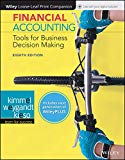
Financial Accounting: Tools for Business Decision Making, 8e WileyPLUS (next generation) + Loose-leaf
8th Edition
ISBN: 9781119491057
Author: Paul D. Kimmel, Jerry J. Weygandt, Donald E. Kieso
Publisher: Wiley (WileyPLUS Products)
expand_more
expand_more
format_list_bulleted
Question
Chapter 13, Problem 2Q
To determine
Earnings per Share: Earnings per share help to measure the profitability of a company. Earnings per share are the amount of profit that is allocated to each share of outstanding stock.
Formula:
To determine:
Whether the trend is favorable or not for Company H.
Given info:
Earnings per share for 2016 and 2017
Expert Solution & Answer
Want to see the full answer?
Check out a sample textbook solution
Students have asked these similar questions
General accounting question
Can you help me solve this general accounting problem with the correct methodology?
compute the accrued interest ....???
Chapter 13 Solutions
Financial Accounting: Tools for Business Decision Making, 8e WileyPLUS (next generation) + Loose-leaf
Ch. 13 - Prob. 1QCh. 13 - Prob. 2QCh. 13 - Prob. 3QCh. 13 - Prob. 4QCh. 13 - Prob. 5QCh. 13 - Prob. 6QCh. 13 - Prob. 7QCh. 13 - Prob. 8QCh. 13 - Prob. 9QCh. 13 - (a) Distinguish among the following bases of...
Ch. 13 - Prob. 11QCh. 13 - Prob. 12QCh. 13 - Prob. 13QCh. 13 - Prob. 14QCh. 13 - Prob. 15QCh. 13 - Prob. 16QCh. 13 - Prob. 17QCh. 13 - Prob. 18QCh. 13 - Prob. 19QCh. 13 - Prob. 20QCh. 13 - Prob. 21QCh. 13 - Prob. 22QCh. 13 - Prob. 13.1BECh. 13 - Prob. 13.2BECh. 13 - Prob. 13.3BECh. 13 - Prob. 13.4BECh. 13 - Prob. 13.5BECh. 13 - Prob. 13.6BECh. 13 - Prob. 13.7BECh. 13 - Prob. 13.8BECh. 13 - Prob. 13.9BECh. 13 - Prob. 13.10BECh. 13 - Prob. 13.11BECh. 13 - Prob. 13.12BECh. 13 - Prob. 13.13BECh. 13 - Prob. 13.14BECh. 13 - Prob. 13.15BECh. 13 - Prob. 13.1DIECh. 13 - Prob. 13.2DIECh. 13 - Prob. 13.3DIECh. 13 - Prob. 13.1ECh. 13 - Prob. 13.2ECh. 13 - Prob. 13.3ECh. 13 - Prob. 13.4ECh. 13 - Prob. 13.5ECh. 13 - Prob. 13.6ECh. 13 - Prob. 13.7ECh. 13 - Prob. 13.8ECh. 13 - Prob. 13.9ECh. 13 - Prob. 13.10ECh. 13 - Prob. 13.11ECh. 13 - Prob. 13.12ECh. 13 - Prob. 13.13ECh. 13 - Prob. 13.1APCh. 13 - Prob. 13.2APCh. 13 - Prob. 13.3APCh. 13 - Prob. 13.4APCh. 13 - Prob. 13.5APCh. 13 - Prob. 13.1EYCTCh. 13 - Prob. 13.2EYCTCh. 13 - Prob. 13.3EYCTCh. 13 - Prob. 13.4EYCTCh. 13 - Prob. 13.7EYCTCh. 13 - Prob. 13.8EYCTCh. 13 - Prob. 13.9EYCTCh. 13 - Prob. 13.1IFRS
Knowledge Booster
Learn more about
Need a deep-dive on the concept behind this application? Look no further. Learn more about this topic, accounting and related others by exploring similar questions and additional content below.Similar questions
- Please provide the solution to this financial accounting question using proper accounting principles.arrow_forwardBelow is information for Blue Company. Using this information, answer the following questions on the "Calculation" tab in the file. Show your work (how you got your answer) and format appropriately. Blue company has prepared the following contribution format income statement based on a sales volume of 1,000 units (the relevant range of production is 500 to 1,500 units): Sales $ 40,000 Variable expenses 24,000 Contribution margin 16,000 NOTE: Use the amounts in the original fact pattern to the left as your basis for the questions below. Fixed expenses 12,000 Net operating income $ 4,000 Questions: 1. What is the contribution margin per unit? 2. What is the contribution margin ratio? 3. What is…arrow_forwardI am looking for help with this financial accounting question using proper accounting standards.arrow_forward
- General accountingarrow_forwardPlease explain the correct approach for solving this general accounting question.arrow_forwardRobin Corporation has ordinary income from operations of $30,000, net long-term capital gain of $10,000, and net short-term capital loss of $15,000. What is the taxable income for 2010? a) $25,000. b) $27,000. c) $28,500. d) $30,000. e) None of the above.arrow_forward
- Please explain the solution to this financial accounting problem using the correct financial principles.arrow_forwardI need the correct answer to this financial accounting problem using the standard accounting approach.arrow_forwardI am trying to find the accurate solution to this general accounting problem with the correct explanation.arrow_forward
arrow_back_ios
SEE MORE QUESTIONS
arrow_forward_ios
Recommended textbooks for you
 Financial AccountingAccountingISBN:9781305088436Author:Carl Warren, Jim Reeve, Jonathan DuchacPublisher:Cengage Learning
Financial AccountingAccountingISBN:9781305088436Author:Carl Warren, Jim Reeve, Jonathan DuchacPublisher:Cengage Learning

Financial Accounting
Accounting
ISBN:9781305088436
Author:Carl Warren, Jim Reeve, Jonathan Duchac
Publisher:Cengage Learning
Financial ratio analysis; Author: The Finance Storyteller;https://www.youtube.com/watch?v=MTq7HuvoGck;License: Standard Youtube License